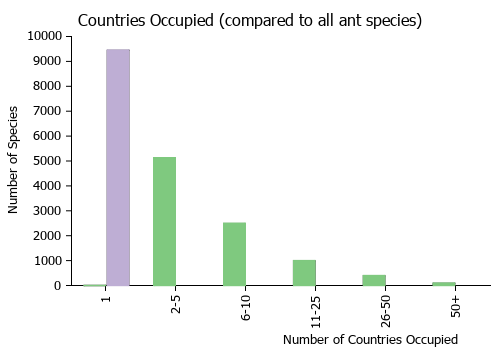Tetraponera vivax
| Tetraponera vivax | |
|---|---|
| Scientific classification | |
| Kingdom: | Animalia |
| Phylum: | Arthropoda |
| Class: | Insecta |
| Order: | Hymenoptera |
| Family: | Formicidae |
| Subfamily: | Pseudomyrmecinae |
| Genus: | Tetraponera |
| Species: | T. vivax |
| Binomial name | |
| Tetraponera vivax Ward, 2001 | |
This species is known only from three queens, collected in Singapore, Sabah and Java. The biology of T. vivax remains a mystery but the configuration of the clypeus suggests specialised (perhaps parasitic) colony-founding habits. (Ward 2001)
Identification
Ward (2001) - The ligulate protrusion on the anterior margin of the clypeus makes the queen of T. vivax instantly recognisable. Other notable features are the elongate head, small eyes, shiny puncticulate integument, and broad profemur.
Keys including this Species
- Key to Tetraponera of the Oriental and Australian regions
- Key to Tetraponera queens of the Oriental and Australian regions
Distribution
Latitudinal Distribution Pattern
Latitudinal Range: 6.05° to -6.583333333°.
| North Temperate |
North Subtropical |
Tropical | South Subtropical |
South Temperate |
- Source: AntMaps
Distribution based on Regional Taxon Lists
Indo-Australian Region: Indonesia (type locality), Singapore.
Distribution based on AntMaps
Distribution based on AntWeb specimens
Check data from AntWeb
Countries Occupied
| Number of countries occupied by this species based on AntWiki Regional Taxon Lists. In general, fewer countries occupied indicates a narrower range, while more countries indicates a more widespread species. |

|
Estimated Abundance
| Relative abundance based on number of AntMaps records per species (this species within the purple bar). Fewer records (to the left) indicates a less abundant/encountered species while more records (to the right) indicates more abundant/encountered species. |

|
Biology
Castes
Nomenclature
The following information is derived from Barry Bolton's Online Catalogue of the Ants of the World.
- vivax. Tetraponera vivax Ward, 2001: 647, figs. 104, 105 (q.) INDONESIA (Java).
Unless otherwise noted the text for the remainder of this section is reported from the publication that includes the original description.
Description
Queen
HW 1.30-1.39, HL 2.09-2.18, LHT 1.06-1.12, CI 0.62-0.64, FCI 0.18-0.19, REL 0.24-0.25, REL2 0.38-0.40, SI 0.53, SI3 1.32-1.38, FI 0.56-0.58, PLI 0.49-0.53, PWI 0.44-0.46, LHT/HW 0.80-0.81, CSC 4.
Head elongate, with parallel sides; masticatory margin of mandible with four teeth, with a gap between the 2nd and 3rd teeth; anterior clypeal margin broadly convex and edentate, and with a stout, tongue-like ventromedial protrusion, extending beyond the clypeus proper by about 0.16 mm; frontal carinae moderately well separated, the distance between them about 1.25 x maximum scape width; median lobes of the antennal sclerites expanded laterally and covering most of the antennal insertions, when head is observed in full-face view; malar pit present, transverse; eyes relatively small; lateral pronotal margins present but rather weakly defined; profemur very short and robust; petiole as illustrated, rather long, low and narrow; postpetiole slightly broader than long, not attenuate anteriorly when observed in dorsal view; metabasitarsal sulcus prominent, occupying a darkened patch of cuticle about 3/4 the length of the basitarsus. Integument smooth and shiny, with scattered fine punctures mostly about 0.010 mm in diameter or less; punctures on most of head and mesosoma separated by several diameters, with interspaces smooth and shining; punctures denser and coarser on malar area and posterior portion of katepisternum. Long, standing pilosity moderately common on apex and venter of head, mesosoma dorsum, petiole, postpetiole and gaster, but sparse on upper half of dorsum of head (four setae, in pairs posteromesial to the compound eye). Appressed pubescence scattered over body, mostly not very conspicuous, dense on posterior portion of katepisternum; most appressed hairs on abdominal tergite IV separated by about their lengths, becoming denser towards the anterior margin. Brownish-black, the antennae, protibial and tarsi medium-brown.
Type Material
Holotype. Alate queen: Singapore, no date, Baker (Museum of Comparative Zoology). Labeled as follows: “Singapore/Coli. Baker” and “Gift of W./M. Wheeler”.
References
- Ward, P. S. 2001. Taxonomy, phylogeny and biogeography of the ant genus Tetraponera (Hymenoptera: Formicidae) in the Oriental and Australian regions. Invertebrate Taxonomy. 15:589-665. (page 647, figs. 104, 105 queen described)
- Wang, W.Y., Soh, E.J.Y., Yong, G.W.J., Wong, M.K.L., Benoit Guénard, Economo, E.P., Yamane, S. 2022. Remarkable diversity in a little red dot: a comprehensive checklist of known ant species in Singapore (Hymenoptera: Formicidae) with notes on ecology and taxonomy. Asian Myrmecology 15: e015006 (doi:10.20362/am.015006).
References based on Global Ant Biodiversity Informatics
- Ward P. S. 2001. Taxonomy, phylogeny and biogeography of the ant genus Tetraponera (Hymenoptera: Formicidae) in the Oriental and Australian regions. Invertebrate Taxonomy 15: 589-665.
- Ward, P. S. 2001. Taxonomy, phylogeny and biogeography of the ant genus Tetraponera (Hymenoptera: Formicidae) in the Oriental and Australian regions. Invertebrate Taxonomy 15:589-665.